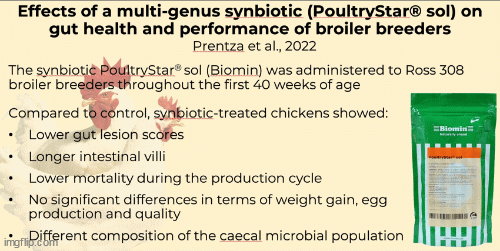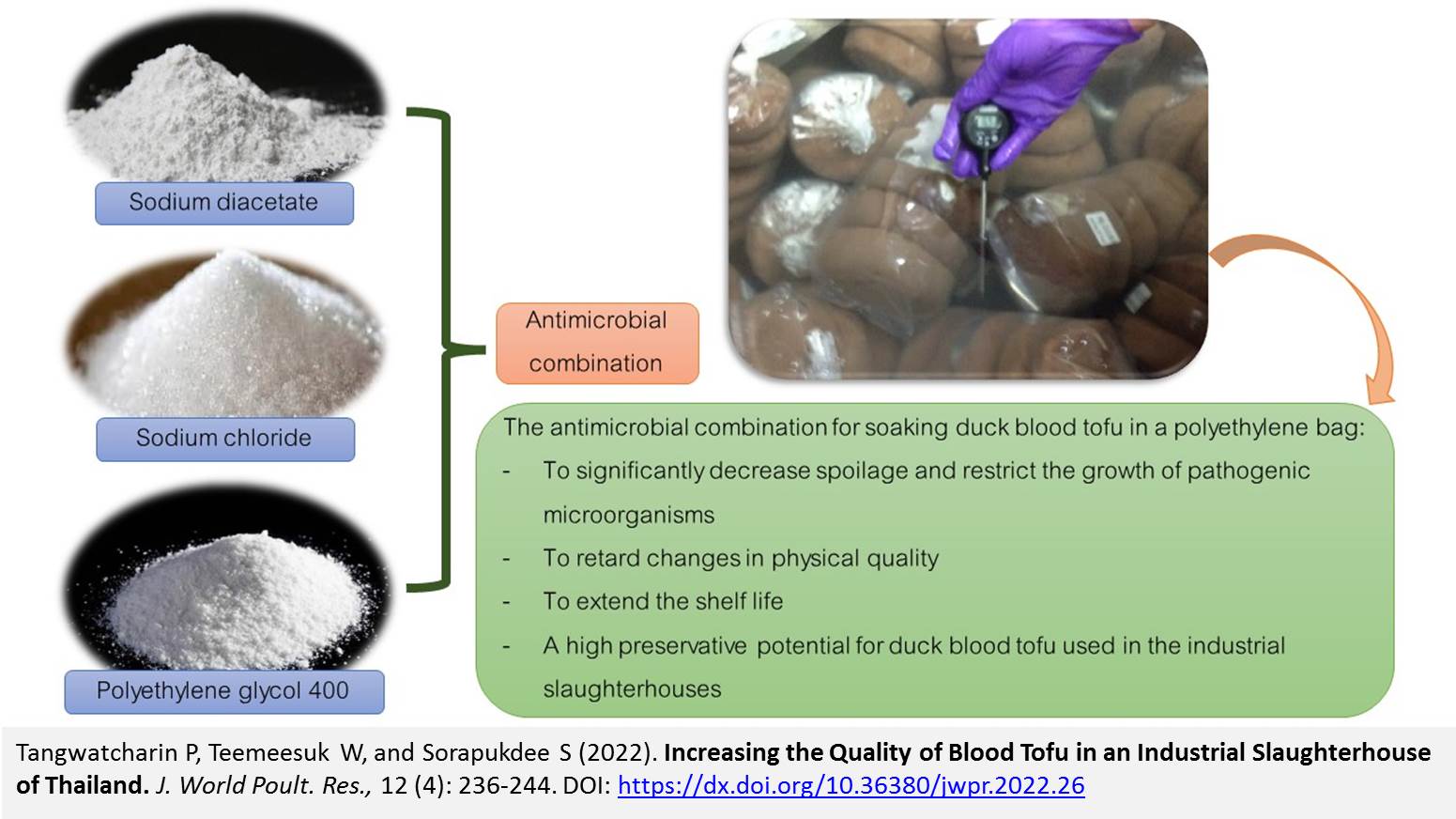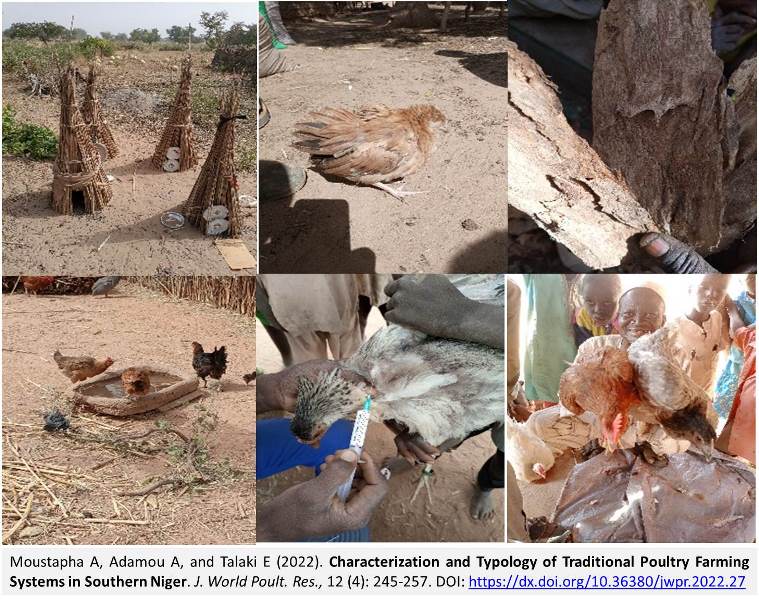Previous issue | Next issue | Archive
Volume 12 (4); December 25, 2022 [Booklet] [Endnote XML for Agris]
Effects of a Multi-Genus Synbiotic (PoultryStar® sol) on Gut Health and Performance of Broiler Breeders
Prentza Z, Castellone F, Legnardi M, Antlinger B, Segura-Wang M, Kefalas G, Fortomaris P, Papaioannou AAN, Stylianaki I, Franzo G, Cecchinato M, Papatsiros V, and Koutoulis K.
J. World Poult. Res. 12(4): 212-229, 2022; pii: S2322455X2200024-12
DOI: https://dx.doi.org/10.36380/jwpr.2022.24
ABSTRACT: In recent years, a rising interest has been directed towards the use of nutraceuticals in the zootechnical sector, including probiotics, prebiotics, and synbiotics, as a way to support production efficiency and cope with the increasing limitations to the use of antibiotics. In poultry, however, most studies on these products have been conducted on broilers, while less information is available on their benefits to other productive categories. The present field study aimed to assess the effects of a multi-species synbiotic product (PoultryStar® sol) on the gut health and productive performance of broiler breeders. A total of 24761 day-old Ross 308 parent stock chicks were acquired from a single hatchery and placed on the same farm. Female chicks were divided into three groups and raised in different houses (A, B, and C), in which males were introduced at the age of mating and followed until 40 weeks of age. The synbiotic was provided by drinking water to the flocks in houses A and B, while house C was kept as control. Following the manufacturer’s guidelines, the product was administered intermittently once every two weeks, except in the first and the twenty-first week when it was supplied for three consecutive days. Data on performance parameters, egg quality traits, bacterial enteritis scoring, intestinal morphometry, and histopathology were recorded, and the caecal content was collected at 15, 25, and 40 weeks of age to investigate the intestinal microbiota using high-throughput next-generation sequencing. Synbiotic-treated hens showed significantly higher survivability during production compared to the control group. No clear differences were observed between treated and control chickens in terms of egg production and quality, and the effect of the synbiotic on weight gain also appeared limited. From 25 weeks onwards, synbiotic-treated chickens scored better in terms of macroscopical lesions and had longer intestinal villi. Significant differences in crypt length and histopathological lesions were also found at multiple sampling points. A treatment effect on caecal bacterial composition was detected with a differential abundance of Gastranaerophilales, Lachnospiraceae, Helicobacter, Ruminococcaceae, and Clostridia, among others. Taken together, obtained results support the beneficial effects of the intermittent administration of the synbiotic product PoultryStar® sol on the gut health of broiler breeders.
Keywords: Broiler breeder, Gastrointestinal health, Histopathology, Microbiota, Synbiotic
[Full text-PDF] [Crossref Metadata] [Scopus] [Export from ePrints]
| Identification of Adeno-associated Virus in Muscovy Ducks with Chronic Diarrhea |
Research Paper
Identification of Adeno-associated Virus in Muscovy Ducks with Chronic Diarrhea
Sallam HM and Zanaty AM.
J. World Poult. Res. 12(4): 230-235, 2022; pii: S2322455X2200025-12
DOI: https://dx.doi.org/10.36380/jwpr.2022.25
ABSTRACT: Adeno-associated viruses (AAVs) are defective members of the genus Dependoparvovirus. Waterfowl parvoviruses, another member of the Dependoparvovirus, were found to be the closest relative of AAVs. This study was performed to identify the genetic changes that may occur to goose parvovirus (GPV) in one Muscovy duck flock that was observed for 12 weeks after the virus was isolated. Persistent watery diarrhea and wing deformity were the common signs. Cloacal swabs were collected from diseased ducks. Unexpectedly, the identified virus was an AAV. The closest strains were duck AAVs at the nucleotide level, identified in Australia and China. Meanwhile, only 52.3% of nucleotide identity was shared with the GPV strain, previously identified from this flock. Duck adenovirus (DAdV) could not be identified in the samples. This study is one of the first studies in which genetic changes of GPV were tracked. In addition, emerging duck AAV from GPV is suggested, which will be useful for future virus classification.
Keywords: Adeno-associated virus, Chronic diarrhea, Muscovy ducks
[Full text-PDF] [Crossref Metadata] [Scopus] [Export from ePrints]
|
Increasing the Quality of Blood Tofu in an Industrial Slaughterhouse of Thailand |
Research Paper
Increasing the Quality of Blood Tofu in an Industrial Slaughterhouse of Thailand
Tangwatcharin P, Teemeesuk W, and Sorapukdee S.
DOI: https://dx.doi.org/10.36380/jwpr.2022.26
J. World Poult. Res. 12(4): 236-244, 2022; pii: S2322455X2200026-12
ABSTRACT: Blood tofu, or cooked duck blood curd, is a Chinese delicacy in East Asia. Its quality and shelf-life are low due to microorganism contamination during production. Therefore, the present study was performed to investigate the role of sodium diacetate (SD), sodium chloride (NaCl), and polyethylene glycol 400 (PEG) combinations in increasing the quality of blood tofu. A total of 45 cooked duck blood curd samples were randomly divided into 3 groups with 3 replicates per group. The first two groups were used to investigate the effect of SD, NaCl, and PEG combinations on microbiological and physical analyses for non-inoculated samples. Another group was used to determine the effect of antimicrobial combinations on Lactobacillus plantarum, Pseudomonas fluorescens, Salmonella typhimurium, Escherichia coli, and Staphylococcus aureus in inoculated samples that were inoculated with these bacteria. All groups were treated with control-sterilized water, 0.15% SD (w/v) + 1.25% NaCl (w/v), 0.30% SD (w/v) + 1.25% NaCl (w/v), 0.15% SD (w/v) + 0.15% PEG (w/v), and 0.15% SD (w/v) + 1.25% NaCl (w/v) + 0.15% PEG (w/v). The results indicated that soaking cooked duck blood curd samples in antimicrobial agent combinations could reduce mesophile and psychrophile bacteria counts in non-inoculated samples. Additionally, 0.15% SD + 1.25% NaCl + 0.15% PEG combination had a higher reduction in mesophile and psychrophile counts, compared to soaking the samples in 0.30% SD + 1.25% NaCl, 0.15% SD + 1.25% NaCl and 0.15% SD + 0.15% PEG combinations. Similarly, this combination showed a significant decrease in lactic acid bacteria, Pseudomonas, Salmonella, Escherichia coli, and Staphylococcus aureus counts in inoculated samples. Furthermore, soaking the samples in 0.15% SD + 1.25% NaCl + 0.15% PEG combination did not negatively affect the samples’ physical quality. Soaking the samples in 0.15% SD + 1.25% NaCl + 0.15% PEG combination inhibited the growth of mesophile, psychrophile, and Pseudomonas in non-inoculated samples after storage for 10, 6, 10, and 8 days in a slaughter warehouse at 7℃, respectively, and extended shelf-life of samples for 16 days. Regarding physical quality changes, this treatment delayed the reduction of pH, hue, hardness, and chewiness of the samples after storage for 10, 8, 12, and 10 days, respectively. Thus, SD, NaCl, and PEG combination had a high preservative potential for cooked duck blood curd used in industrial slaughterhouses.
Keywords: Blood curd, Duck, Organic acid salt, Polyethylene glycol, Quality changes
[Full text-PDF] [Crossref Metadata] [Scopus] [Export from ePrints]
|
Characterization and Typology of Traditional Poultry Farming Systems in Southern Niger |
Research Paper
Characterization and Typology of Traditional Poultry Farming Systems in Southern Niger
Moustapha A, Adamou A, and Talaki E.
J. World Poult. Res. 12(4): 245-257, 2021; pii: S2322455X2200027-12
DOI: https://dx.doi.org/10.36380/jwpr.2022.27
ABSTRACT: An appropriate agricultural policy that integrates knowledge of endogenous poultry practices should enhance household resilience by contributing to food and nutrition security and sustainable development in developing countries. The current cross-sectional survey aimed to characterize poultry breeding systems and identify types of traditional poultry farmers in Maradi and Zinder in southern Niger. Therefore, 600 households were investigated for the socio-economic parameters of poultry farmers, the breeding methods, the zootechnical parameters of the local chicken, and the health parameters relating to biosecurity and animal care. The results of the descriptive analyses indicated that traditional poultry activity is mainly carried out by men (73.5%) and small farmers (74.2%). Breeding management was primarily free-range breeding (99.3%). The majority of the surveyed herders (67.8%) were illiterate. However, 41.5% of them attended traditional Islamic Koranic schools. Most farmers (80%) were small-scale livestock farmers with an average herd size of 22 ± 24.9. The poultry raised were 93.3% local breeds, with chicken domination (66%). The housing did not meet the required standards, and the feed was mainly cereals. The female chicken can potentially produce 12.64 fertile eggs per clutch and brood 3.53 times per year. The leading cause of mortality in poultry was avian diseases (93.7%) and Newcastle disease in some cases. Poultry vaccination against Newcastle disease was reported by 31.5% of respondents. Of the respondents, 20% have partially observed hygiene and biosecurity measures. About 35.5% of the participants reported the provision of veterinary care, while 44% used phytotherapy to prevent or treat poultry diseases. Based on the results of this cluster analysis, three classes of poultry farmers were distinguished, each with specific characteristics. Poultry farmers in class 1 were particularly characterized by the diversity of their main activity and their level of education, those in class 2 were mostly employed in agriculture and had little school experience, and those in class 3 were characterized by their low level of vaccination practice and their lack of therapeutic animal care. The results also indicated that 15.7%, 70.8%, and 13.5% of poultry farmers belonged to classes 1, 2, and 3, respectively.
Keywords: Characterization, Farmer, Niger, Poultry diseases, Poultry production
[Full text-PDF] [Crossref Metadata] [Scopus] [Export from ePrints]
Review
The Importance of Poultry Meat in Medicine: A Review
Jilo SA and Hasan LA.
J. World Poult. Res. 12(4): 258-262, 2022; pii: S2322455X2200028-12
DOI: https://dx.doi.org/10.36380/jwpr.2022.28
ABSTRACT: The animal products, such as meat, milk, skin, blood, honey, and urine, have medicinal value for human diseases. Due to having high-quality components, poultry meat has therapeutic value. The present review aimed to describe the medicinal values of poultry meat for individuals who consume it during their life. Most poultry meat is classified as white meat, which contains lower fat and higher protein, compared with the meat of ovine, bovine, and pig. This feature of poultry meat (lower fat and higher protein) helps its consumers to have a normal physiological function of different organ systems. Moreover, it prevents many non-infectious diseases, including overweight, diabetes, and cardiovascular diseases. Selenium and low contents of carcinogenic substances (myoglobin, heme iron, and saturated fat) in poultry meat also prevent different types of cancers. Poultry meat is also recommended to avoid anemia, cardiovascular diseases, and diabetes. Dietary proteins, vitamins, and minerals in chicken meat are used for anti-aging, developing muscle and bone, improving the immune system, and increasing brain function. Traditionally, poultry is recommended as a supportive treatment for respiratory diseases, such as the common cold. Thus, consumption of poultry meat, especially chickens, up to 300g/once a week is recommended to prevent and reduce the risks of gastrointestinal cancers such as oesophageal cancer. Generally, regular consumption of poultry meat has health benefits for humans to prevent and reduce the risk of different diseases as chicken meat is a rich source of nutrition that can enhance the immunity system and tackle human disease risk factors.
Keywords: Consumption, Health benefits, Meat, Poultry
[Full text-PDF] [Crossref Metadata] [Scopus] [Export from ePrints]
Previous issue | Next issue | Archive
This work is licensed under a Creative Commons Attribution 4.0 International License (CC BY 4.0).![]()





